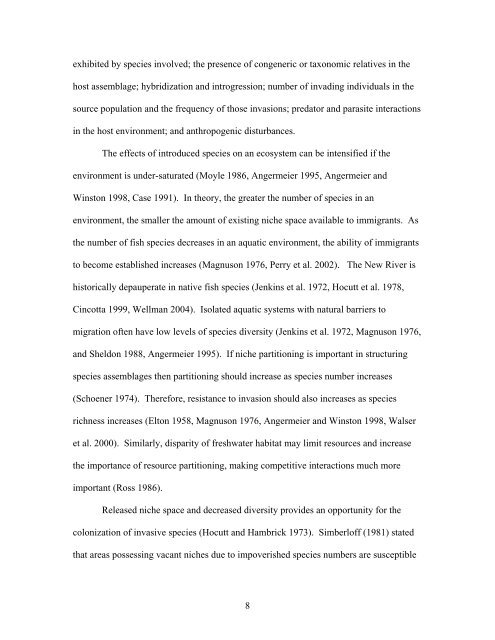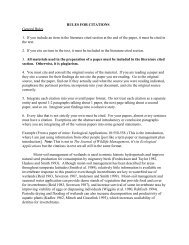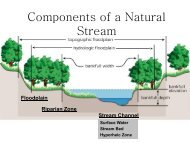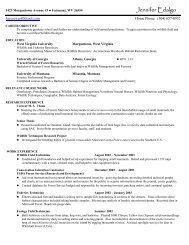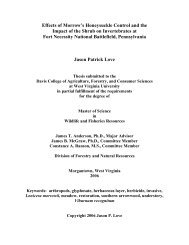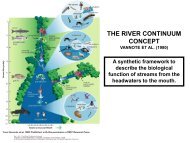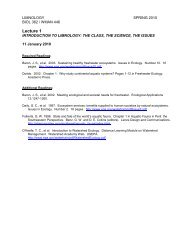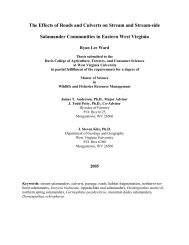An Experimental Study of Vertical Habitat Use and Habitat Shifts in ...
An Experimental Study of Vertical Habitat Use and Habitat Shifts in ...
An Experimental Study of Vertical Habitat Use and Habitat Shifts in ...
Create successful ePaper yourself
Turn your PDF publications into a flip-book with our unique Google optimized e-Paper software.
exhibited by species <strong>in</strong>volved; the presence <strong>of</strong> congeneric or taxonomic relatives <strong>in</strong> the<br />
host assemblage; hybridization <strong>and</strong> <strong>in</strong>trogression; number <strong>of</strong> <strong>in</strong>vad<strong>in</strong>g <strong>in</strong>dividuals <strong>in</strong> the<br />
source population <strong>and</strong> the frequency <strong>of</strong> those <strong>in</strong>vasions; predator <strong>and</strong> parasite <strong>in</strong>teractions<br />
<strong>in</strong> the host environment; <strong>and</strong> anthropogenic disturbances.<br />
The effects <strong>of</strong> <strong>in</strong>troduced species on an ecosystem can be <strong>in</strong>tensified if the<br />
environment is under-saturated (Moyle 1986, <strong>An</strong>germeier 1995, <strong>An</strong>germeier <strong>and</strong><br />
W<strong>in</strong>ston 1998, Case 1991). In theory, the greater the number <strong>of</strong> species <strong>in</strong> an<br />
environment, the smaller the amount <strong>of</strong> exist<strong>in</strong>g niche space available to immigrants. As<br />
the number <strong>of</strong> fish species decreases <strong>in</strong> an aquatic environment, the ability <strong>of</strong> immigrants<br />
to become established <strong>in</strong>creases (Magnuson 1976, Perry et al. 2002). The New River is<br />
historically depauperate <strong>in</strong> native fish species (Jenk<strong>in</strong>s et al. 1972, Hocutt et al. 1978,<br />
C<strong>in</strong>cotta 1999, Wellman 2004). Isolated aquatic systems with natural barriers to<br />
migration <strong>of</strong>ten have low levels <strong>of</strong> species diversity (Jenk<strong>in</strong>s et al. 1972, Magnuson 1976,<br />
<strong>and</strong> Sheldon 1988, <strong>An</strong>germeier 1995). If niche partition<strong>in</strong>g is important <strong>in</strong> structur<strong>in</strong>g<br />
species assemblages then partition<strong>in</strong>g should <strong>in</strong>crease as species number <strong>in</strong>creases<br />
(Schoener 1974). Therefore, resistance to <strong>in</strong>vasion should also <strong>in</strong>creases as species<br />
richness <strong>in</strong>creases (Elton 1958, Magnuson 1976, <strong>An</strong>germeier <strong>and</strong> W<strong>in</strong>ston 1998, Walser<br />
et al. 2000). Similarly, disparity <strong>of</strong> freshwater habitat may limit resources <strong>and</strong> <strong>in</strong>crease<br />
the importance <strong>of</strong> resource partition<strong>in</strong>g, mak<strong>in</strong>g competitive <strong>in</strong>teractions much more<br />
important (Ross 1986).<br />
Released niche space <strong>and</strong> decreased diversity provides an opportunity for the<br />
colonization <strong>of</strong> <strong>in</strong>vasive species (Hocutt <strong>and</strong> Hambrick 1973). Simberl<strong>of</strong>f (1981) stated<br />
that areas possess<strong>in</strong>g vacant niches due to impoverished species numbers are susceptible<br />
8


